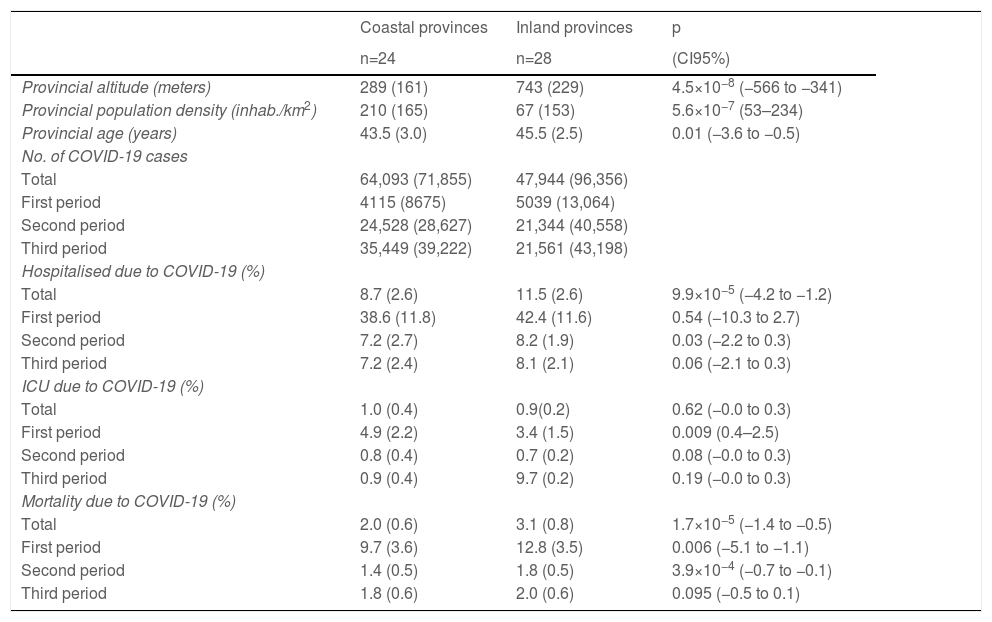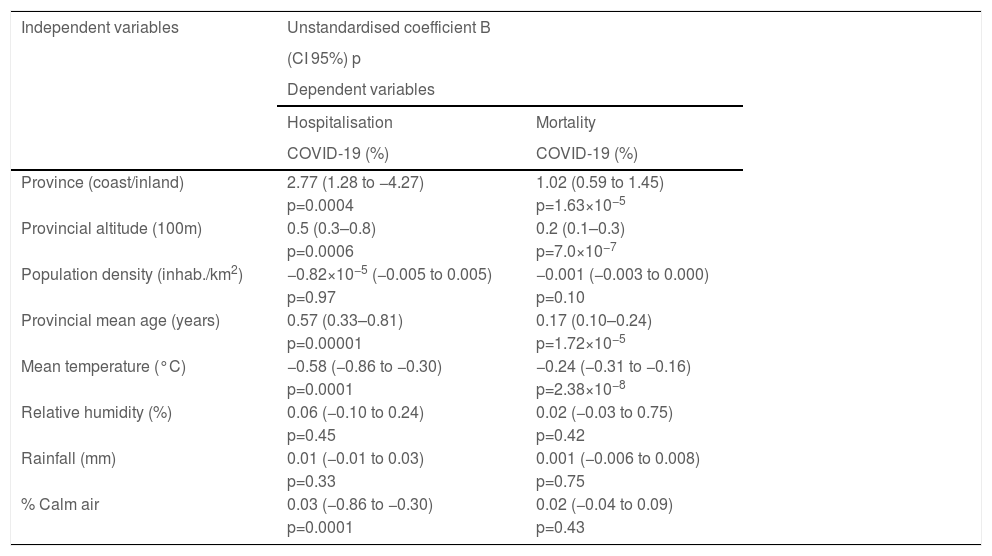Evaluating whether meteorological and geographical variables could be associated with the severity of COVID-19 in Spain.
MethodsAn ecological study was performed to analyze the influence of meteorological and geographical factors in hospital admissions and deaths due to COVID-19 in the 52 provinces of Spain (24 coastal and 28 inland regions), during the first three pandemic waves. Medical and mortality data were collected from the Carlos III Health Institute (ISCIII) and meteorological variables were requested to the Spanish State Meteorological Agency (AEMET).
ResultsRegarding the diagnosed cases it is remarkable that the percentage of patients hospitalized for COVID-19 was lower in the coastal provinces than in the inland ones (8.7±2.6% vs. 11.5±2.6%; p=9.9×10−5). Furthermore, coastal regions registered a lower percentage of mortality than inland regions (2.0±0.6% vs. 3.1±0.8%; p=1.7×10−5). Mean air temperature was inversely correlated both with COVID-19 hospitalizations (Rho: −0.59; p=3.0×10-6) and mortality (Rho: −0.70; p=5.3×10−9). In those provinces with a mean air temperature <10°C mortality by COVID-19 was twice that of those with >16°C. Finally, we found an association between mortality and the location of the province (coastal/inland), altitude, patient age and the average air temperature; the latter was inversely and independently correlated with mortality (non standardised B coeff.: −0.24; IC 95%: −0.31 to −0.16; p=2.38×10−8).
ConclusionsThe average air temperature was inversely associated with COVID-19 mortality in our country during the first three waves of the pandemic.
Evaluar si factores meteorológicos y geográficos pudieron relacionarse con la gravedad de la COVID-19 en España.
MétodosEstudio ecológico, a escala provincial, que analiza la influencia de factores meteorológicos y geográficos en la hospitalización y mortalidad por COVID-19 en las 52 provincias españolas (24 costeras y 28 del interior), durante las tres primeras olas. Los datos de hospitalizaciones y mortalidad se obtuvieron del Instituto de Salud Carlos III (ISCIII). Los datos epidemiológicos del Instituto Nacional Estadística (INE) y la Red Nacional de Vigilancia Epidemiológica (RENAVE). Las variables meteorológicas de la Agencia estatal de meteorología (AEMET).
ResultadosEl porcentaje de pacientes hospitalizados por COVID-19, del total de personas infectadas, fue inferior en las provincias costeras que en las del interior peninsular (8,7±2,6% vs. 11,5±2,6%; p=9,9×10−5). De igual manera la costa registró menor porcentaje de mortalidad que el interior peninsular (2,0±0,6% vs. 3,1±0,8%; p=1,7×10−5). La temperatura media correlacionó negativamente con la hospitalización (Rho: −0,59; p=3,0×10−6) y la mortalidad por COVID-19 (Rho: −0,70; p=5,3×10−9). Las provincias con una temperatura media <10°C duplicaron la mortalidad por COVID respecto a las de >16°C. La mortalidad se relacionó con la localización provincial (costa/interior), la altitud, la edad de la población y la temperatura media, siendo esta última la variable asociada de manera independiente (Coef. B no estandarizado: −0,24; IC 95%: −0,31 a −0,16; p=2,38×10−8).
ConclusionesLa mortalidad por COVID-19 durante las tres primeras olas de la pandemia en nuestro país se asoció inversamente con la temperatura media.












